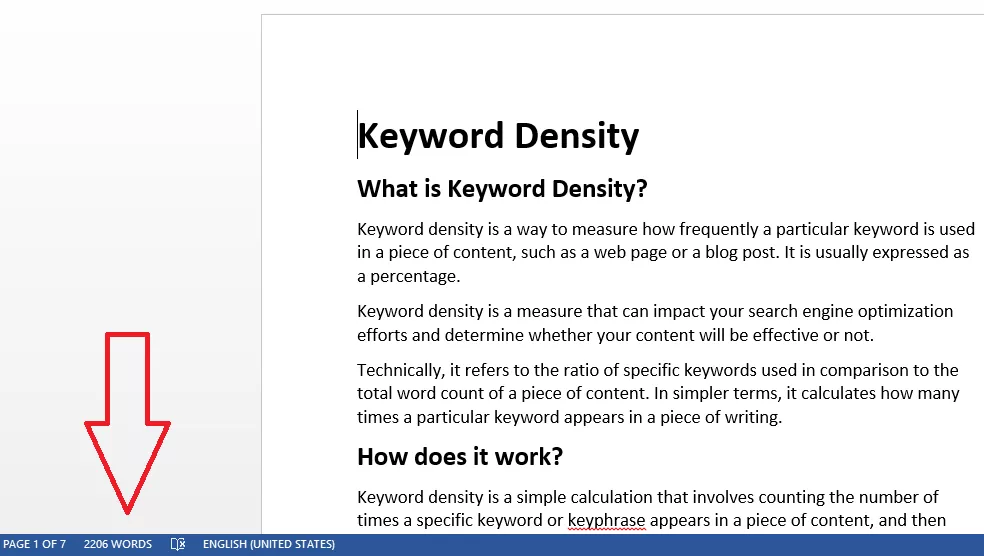What is Keyword Density?
Keyword density is a way to measure how frequently a particular keyword is used in a piece of content, such as a web page or a blog post. It is usually expressed as a percentage.
Keyword density is a measure that can impact your search engine optimization efforts and determine whether your content will be effective or not.
Technically, it refers to the ratio of specific keywords used in comparison to the total word count of a piece of content.
In simpler terms, it calculates how many times a particular keyword appears in a piece of writing.
How does it work?
Keyword density is a simple calculation that involves counting the number of times a specific keyword or keyphrase appears in a piece of content, and then dividing that by the total number of words in the content.
The resulting number is then multiplied by 100 to get the percentage of keyword density.
For example, if you use your target keyword 10 times in a 1000-word blog post, your keyword density would be 1%.
This is calculated by dividing 10 (the number of times the keyword appears) by 1000 (the total number of words on the page), which gives you 0.01, and then multiplying by 100 to get the percentage (1%).
Is keyword density important for SEO?
Keyword density used to be considered an important factor for SEO in the past. However, with the evolution of search engine algorithms, keyword density has become less significant as a standalone factor for SEO.
Today, search engines place more emphasis on the overall quality, relevance, and user experience of the content, rather than just keyword density.
Keyword stuffing, which is the practice of excessively and unnaturally stuffing keywords into content, can actually have a negative impact on SEO as search engines may penalize websites for such practices.
While it's still important to include relevant keywords in your content to signal to search engines what your content is about, the focus should be on creating high-quality, valuable content for users, rather than solely focusing on keyword density.
It's essential to strike a balance between incorporating keywords naturally into your content and ensuring that the content provides value, relevance, and engagement for the users.
This approach, along with other SEO best practices, can help improve the overall search engine visibility and performance of your content.
How to check it?
You can check it in three different ways depending on which method seems more reliable to you.
Word file search
This method involves using the search function in a word processing software like Microsoft Word to manually check the keyword density in a document.
Here's how it works:
Open the Word file where you have written the content, or copy and paste the content from your webpage into a new Word document.
Press Ctrl+F to open the navigation box, which allows you to search for specific words or phrases within the document.
Type the keyword you want to check in the navigation box and press Enter. The word processing software will then highlight all occurrences of that keyword in the document.
Take note of the total number of times the keyword appears in the document, which you can see in the navigation box or by manually counting the highlighted occurrences.
At the bottom left corner, you will find the total word count.

Use the formula “keyword count ÷ word count × 100” to calculate the keyword density. For example, if the keyword appears 20 times in a document with a total word count of 1000, the keyword density would be (20 ÷ 1000) × 100 = 2%.
This method allows you to manually calculate the keyword density by using the search function in a word processing software to find the occurrences of the keyword and then applying a simple formula to calculate the percentage of keyword density about the total word count of the document.
Tools
To save time and make the results more reliable, you can use tools.
Keyword Density Checker
The Keyword Density Checker is a dedicated tool that allows you to input your content and a target keyword.
It then analyzes your content and calculates the keyword density, which is the percentage of times the target keyword appears in the content relative to the total word count.
This tool helps you easily determine the keyword density in your content, which can help you optimize your content for SEO purposes.
Yoast SEO plugin
The Yoast SEO plugin offers a built-in keyword density checker feature that can help you analyze your content and provide feedback on the usage and density of keywords.
It can highlight the keywords used in your content and provide suggestions for improving keyword usage and density.
This can be a convenient tool for WordPress users to ensure that their content meets the recommended keyword density guidelines and optimize their content for SEO purposes.
Using these tools can save you time and provide you with more reliable results when checking keyword density.
TF-IDF
TF-IDF stands for the “term frequency-inverse document frequency”. term frequency refers to the frequency of a term appearing on a specific page.
On the other hand, IDF tells us the frequency of the same word appearing on other web pages of your website.
Precisely, it is the number of times a word is present in a single document or a piece of content relative to all the documents/pieces of content belonging to textual data of a single site.
TF is easy to work out as it is what the value tells you. However, IDF has an inverse value that you can measure between 0 and 1. A value closer to 0 means the word appears more often in the content while closer to 1 means the opposite.
You can measure it through an equation/formula.
Here's how it works:
The TF-IDF value for a term in a document is calculated by multiplying the Term Frequency (TF) and the Inverse Document Frequency (IDF) of that term. The formula is:
TF-IDF = TF * log(N/DF)
where:
TF: Term Frequency (number of times a term appears in the document divided by the total number of terms in the document)
N: Total number of documents in the collection or website
DF: Number of documents containing the term
TF is a straightforward value that represents the frequency of a term in a document. IDF, on the other hand, has an inverse value between 0 and 1.
A lower IDF value (closer to 0) indicates that the term appears more frequently in the documents, while a higher IDF value (closer to 1) indicates that the term appears less frequently in the documents.
What is the ideal keyword density for SEO?
There is no specific "ideal" keyword density for SEO, as search engines do not provide explicit guidelines on what percentage of keyword density is considered optimal.
In fact, search engines have become more sophisticated in analyzing content and evaluating its quality, relevance, and user experience, rather than relying solely on keyword density as a ranking factor.
As such, it is not recommended to focus solely on achieving a specific keyword density percentage in your content.
Instead, the emphasis should be on creating high-quality, valuable, and relevant content that meets the needs of your target audience.
The content should be written naturally and engagingly, with keywords incorporated organically and contextually.
Best practices for keyword density
While keyword density is not as crucial as it used to be for SEO, here are some best practices to keep in mind when incorporating keywords into your content:
Write for users, not search engines
Focus on creating high-quality, valuable, and engaging content that meets the needs of your target audience.
Avoid keyword stuffing or unnatural keyword placement, as it can negatively impact the user experience and SEO.
Conduct proper keyword research
Use keyword research tools to identify relevant keywords that are commonly used by your target audience in search queries.
Choose keywords that are relevant to your content and have reasonable search volume and competition.
Incorporate keywords organically
Incorporate keywords naturally into your content in a way that makes sense to users and fits seamlessly into the flow of the content. Avoid overusing keywords and aim for a natural and contextual placement.
Focus on relevance and user intent
Ensure that your content is relevant to the topic and intent of the user's search query. Create content that provides valuable information and answers the user's queries effectively.
Diversify your keywords
Avoid overusing a single keyword and aim to diversify your keyword usage.
Use synonyms, variations, and related terms to make your content more natural and comprehensive.
Incorporate keywords and their variations in headers and subheadings, as search engines often consider these as important indicators of content relevance.
While there is no ideal keyword density, it's still a good practice to keep an eye on it.
Avoid excessively high keyword density, as it can be seen as keyword stuffing by search engines.
Regularly review and optimize your existing content for keyword usage, relevance, and user experience.
Update your content with new and relevant keywords as needed.
Is keyword density a Google ranking factor?
Keyword density is not a direct ranking factor for Google. Google's algorithms have evolved over time to prioritize user-focused content that provides value and relevance, rather than simply counting the number of times a keyword appears in a piece of content.
Google's ranking algorithms now consider various factors such as user intent, content quality, relevance, engagement, backlinks, website authority, and many other signals to determine the ranking of a web page.
Google has confirmed this multiple times and has discouraged SEOs from focusing excessively on keyword density.
While keyword density may have been a more significant factor in the past, it is not as crucial in modern SEO.
Over-optimizing for keyword density or engaging in keyword stuffing can even result in penalties from Google, as it is considered a spammy practice.
It's important to focus on creating high-quality, valuable content that meets the needs of your target audience, rather than obsessing over keyword density.
Takeaway
Keyword density is a measure of how often a specific keyword appears in a piece of content relative to the total word count.
It used to be considered an important factor for SEO, but search engines now focus more on overall content quality and relevance.
Keyword stuffing, or excessive use of keywords, can actually harm SEO.
Balancing keyword usage naturally with high-quality content is key for effective SEO.


